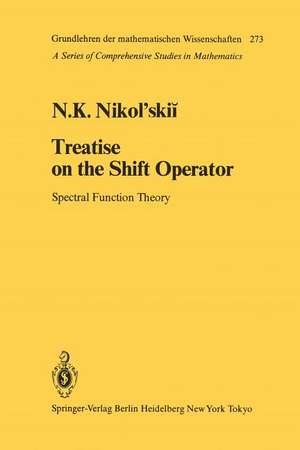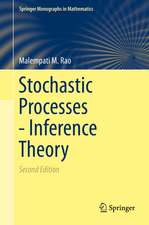Treatise on the Shift Operator: Spectral Function Theory: Grundlehren der mathematischen Wissenschaften, cartea 273
Apendix de S. V. Hruscev Autor N. K. Nikol'skii Traducere de J. Peetre Apendix de V.V. Pelleren Limba Engleză Paperback – 20 noi 2011
Din seria Grundlehren der mathematischen Wissenschaften
-
 Preț: 353.84 lei
Preț: 353.84 lei - 24%
 Preț: 728.15 lei
Preț: 728.15 lei -
 Preț: 410.22 lei
Preț: 410.22 lei - 24%
 Preț: 587.88 lei
Preț: 587.88 lei - 17%
 Preț: 498.74 lei
Preț: 498.74 lei -
 Preț: 592.77 lei
Preț: 592.77 lei - 20%
 Preț: 692.50 lei
Preț: 692.50 lei - 24%
 Preț: 893.31 lei
Preț: 893.31 lei - 20%
 Preț: 824.75 lei
Preț: 824.75 lei - 24%
 Preț: 632.98 lei
Preț: 632.98 lei - 15%
 Preț: 596.69 lei
Preț: 596.69 lei - 15%
 Preț: 714.49 lei
Preț: 714.49 lei -
 Preț: 333.03 lei
Preț: 333.03 lei - 15%
 Preț: 473.16 lei
Preț: 473.16 lei -
 Preț: 356.49 lei
Preț: 356.49 lei -
 Preț: 484.43 lei
Preț: 484.43 lei - 15%
 Preț: 452.79 lei
Preț: 452.79 lei -
 Preț: 456.66 lei
Preț: 456.66 lei - 15%
 Preț: 708.75 lei
Preț: 708.75 lei -
 Preț: 423.08 lei
Preț: 423.08 lei - 15%
 Preț: 444.29 lei
Preț: 444.29 lei - 15%
 Preț: 527.79 lei
Preț: 527.79 lei - 15%
 Preț: 589.65 lei
Preț: 589.65 lei -
 Preț: 353.40 lei
Preț: 353.40 lei - 18%
 Preț: 727.66 lei
Preț: 727.66 lei -
 Preț: 387.96 lei
Preț: 387.96 lei - 15%
 Preț: 454.74 lei
Preț: 454.74 lei - 15%
 Preț: 481.03 lei
Preț: 481.03 lei -
 Preț: 464.55 lei
Preț: 464.55 lei -
 Preț: 348.77 lei
Preț: 348.77 lei -
 Preț: 362.04 lei
Preț: 362.04 lei -
 Preț: 488.12 lei
Preț: 488.12 lei - 15%
 Preț: 447.57 lei
Preț: 447.57 lei -
 Preț: 419.81 lei
Preț: 419.81 lei -
 Preț: 388.52 lei
Preț: 388.52 lei -
 Preț: 419.21 lei
Preț: 419.21 lei - 15%
 Preț: 581.01 lei
Preț: 581.01 lei -
 Preț: 497.75 lei
Preț: 497.75 lei -
 Preț: 360.53 lei
Preț: 360.53 lei -
 Preț: 387.75 lei
Preț: 387.75 lei -
 Preț: 419.81 lei
Preț: 419.81 lei - 18%
 Preț: 725.75 lei
Preț: 725.75 lei -
 Preț: 453.78 lei
Preț: 453.78 lei -
 Preț: 386.39 lei
Preț: 386.39 lei
Preț: 707.00 lei
Preț vechi: 831.76 lei
-15% Nou
Puncte Express: 1061
Preț estimativ în valută:
135.28€ • 147.41$ • 113.100£
135.28€ • 147.41$ • 113.100£
Carte tipărită la comandă
Livrare economică 24 aprilie-08 mai
Preluare comenzi: 021 569.72.76
Specificații
ISBN-13: 9783642701535
ISBN-10: 3642701531
Pagini: 504
Ilustrații: XI, 491 p.
Dimensiuni: 155 x 235 x 26 mm
Greutate: 0.7 kg
Ediția:Softcover reprint of the original 1st ed. 1986
Editura: Springer Berlin, Heidelberg
Colecția Springer
Seria Grundlehren der mathematischen Wissenschaften
Locul publicării:Berlin, Heidelberg, Germany
ISBN-10: 3642701531
Pagini: 504
Ilustrații: XI, 491 p.
Dimensiuni: 155 x 235 x 26 mm
Greutate: 0.7 kg
Ediția:Softcover reprint of the original 1st ed. 1986
Editura: Springer Berlin, Heidelberg
Colecția Springer
Seria Grundlehren der mathematischen Wissenschaften
Locul publicării:Berlin, Heidelberg, Germany
Public țintă
ResearchCuprins
Introductory Lecture. What This Book is About.- 1. Basic Objects.- 2. The Functional Model.- 3. The Details of the Plan.- 4. Concluding Remarks.- Lecture I. Invariant Subspaces.- 1. The Fundamental Theorem.- 2. The Inner-Outer Factorization.- 3. The Arithmetic of Inner Functions.- 4. The Adjoint Operators S*.- Supplements and Bibliographical Notes.- 5. Invariant Subspaces.- 6. The Shift of Arbitrary Multiplicity.- 7. Concluding Remarks.- Lecture II. Individual Theorems for the Operator S*.- 1. Pseudocontinuation of H2-Functions and S*-Cyclicity.- 2. Approximation by Rootspaces.- Supplements and Bibliographical Notes.- 3. More General Capacities.- 4. The Operator SE*.- 5. Concluding Remarks.- Lecture III. Compressions of the Shift and the Spectra of Inner Functions.- 1. The Spectrum of an Operator and the Spectrum of a Function.- 2. Functional Calculus and Derivation of Theorem LM.- 3. The Spectrum of the Operator ?(T).- Supplements and Bibliographical Notes.- 4. The Cyclic Vectors for the Operators T = PS|K and T*.- 5. A Calculus for Completely Non-Unitary Contractions.- 6. The Class C0.- 7. The Characteristic Function and the Spectrum.- 8. Concluding Remarks.- Lecture IV. Decomposition into Invariant Subspaces.- 1. Spectral Synthesis.- 2. Spectral Subspaces.- 3. Unicellular Operators.- Supplements and Bibliographical Notes.- 4. On Invariant Subspaces.- 5. Synthesis for C0-Operators.- 6. On Spectral Subspaces.- 7. Concerning Unicellular Operators.- 8. Concluding Remarks.- Lecture V. The Triangular Form of the Truncated Shift.- 1. Pure Point Spectrum.- 2. Continuous Singular Spectrum.- 3. Atomic Singular Spectrum.- 4. The General Case and Applications.- Supplements and Bibliographical Notes.- 5. Triangular Representations of More General Operators.- 6. ConcludingRemarks.- Lecture VI. Bases and Interpolation (Statement of the Problem).- 1. Riesz Bases.- 2. Interpolation.- 3. Spectral Projections and Unconditional Convergence.- Supplements and Bibliographical Notes.- 4. Bases of Subspaces.- 5. Bases of Eigenspaces.- 6. Concluding Remarks.- Lecture VII. Bases and Interpolation (Solution).- 1. Carleson Measures.- 2. Proof of the Theorem on Bases and Interpolation.- 3. Analysis of Carleson’s Condition (C).- Supplements and Bibliographical Notes.- 4. Carleson Series.- 5. Remarks on Imbedding Theorems.- 6. Concluding Remarks.- Lecture VIII. Operator Interpolation and the Commutant.- 1. Interpolation by Bounded Analytic Functions.- 2. The Proof of Sarason’s Theorem.- 3. Compact Operators in T??.- Supplements and Bibliographical Notes.- 4. The Multiplier Method and the Operator Calculus.- 5. Summation Bases.- 6. Hankel Operators and Angles Between Subspaces.- 7. Concluding Remarks.- Lecture IX. Generalized Spectrality and Interpolation of Germs of Analytic Functions.- 1. Generalized Spectrality.- 2. Non-Classical Interpolation in H? and Bases.- 3. The Rôle of the Uniform Minimality.- 4. Interpolation of Germs of Analytic Functions.- 5. Splitting and Blocking of Rootspaces.- 6. Spectrality and B0-Spectrality.- 7. Concluding Remarks.- Lecture X. Analysis of the Carleson-Vasyunin Condition.- 1. An Estimate for the Angle in Terms of Representing Measures.- 2. Bases of Rootspaces.- 3. Stolzian Spectrum.- 4. Singular Discrete Spectrum.- 5. Counterexamples.- 6. Concluding Remarks.- Lecture XI. On the Line and in the Halfplane.- 1. The Invariant Subspaces.- 2. Bases of Exponentials.- 3. Concluding Remarks.- Appendix 4. Essays on the Spectral Theory of Hankel and Toeplitz Operators.- (For detailed contents see page 300).- (Fordetailed contents see page 400).- List of Symbols.- Author Index.












